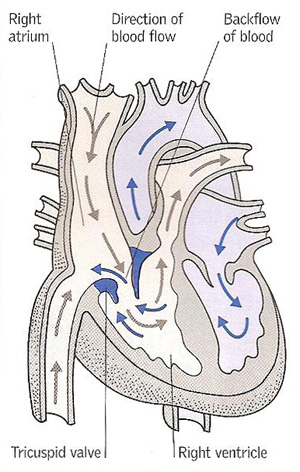tricuspid valve

Tricuspid incompetence.
The tricuspid valve is the valve in the heart between the right atrium and right ventricle. It consists of three cusps that channel the flow of blood from the atrium to the ventricle and prevent any backflow.
Disorders of the tricuspid
Tricuspid incompetence
Also called tricuspid regurgitation, failure of the tricuspid valve to close fully, allowing blood to leak into the right atrium (upper chamber) when the right ventricle (lower chamber) contracts. It reduces the heart's pumping efficiency.
The usual cause of tricuspid incompetence is pulmonary arterial hypertension (high pressure in the blood supply to the lungs). More rarely, it follows rheumatic fever, or, in intravenous drug users, bacterial infection of the heart.
Tricuspid incompetence results in symptoms of right-sided heart failure, notably edema (fluid swelling) of the ankles and abdomen. The liver is swollen and tender, and veins in the neck are distended.
A diagnosis is made from the symptoms, from hearing a heart murmur through a stethoscope, and tests that may include ECG, chest X-rays, echocardiography, and cardiac catheterization. Treatment with diuretic drugs and ACE inhibitors often relieves the symptoms.
Tricuspid stenosis
Narrowing of the opening of the tricuspid valve, usually caused by a previous attack of rheumatic fever. Tricuspid stenosis is uncommon and often occurs in conjunction with another heart-valve disorder. For example, tricuspid incompetence may also occur in intravenous drug users who have a bacterial infection of the heart. Tricuspid stenosis causes enlargement of the right atrium. The symptoms and diagnosis of tricuspid stenosis are similar to those of tricuspid incompetence. Treatment is with drugs such as diuretic drugs and sometimes with a digitalis drug. Heart-valve surgery may sometimes be needed.


